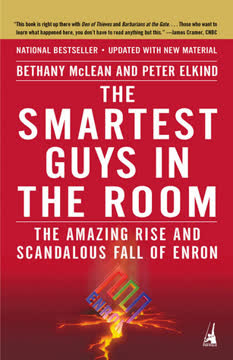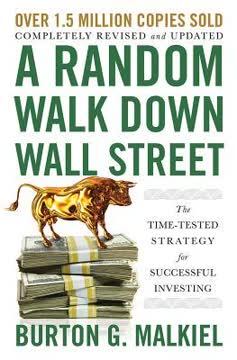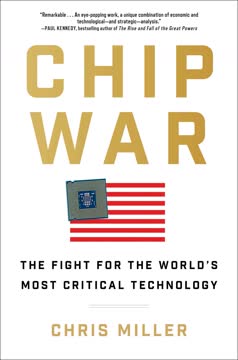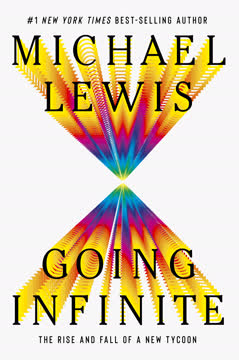Key Takeaways
1. The subprime mortgage crisis: A perfect storm of greed and ignorance
"The problem wasn't confined to individual stocks. The Internet bubble had burst, and yet house prices in San Jose, the bubble's epicenter, were still rising."
A brewing disaster. The subprime mortgage crisis emerged from a combination of factors that created a perfect storm in the financial markets. Low interest rates, relaxed lending standards, and a booming housing market led to a surge in subprime mortgages – loans given to borrowers with poor credit histories.
Systemic failures. Financial institutions packaged these risky loans into complex securities, which were then sold to investors worldwide. The assumption was that housing prices would continue to rise indefinitely, and that the risk was spread out enough to be negligible. This assumption proved catastrophically wrong.
Key players in the crisis:
- Mortgage lenders
- Investment banks
- Credit rating agencies
- Regulators
- Homeowners
2. Wall Street's dangerous obsession with complex financial instruments
"The constant argument over the value of the shares of some major publicly traded company has very little value, as both buyer and seller can see the fair price of the stock on the ticker, and the broker's commission has been driven down by competition."
Financial alchemy. Wall Street firms created increasingly complex financial instruments, such as collateralized debt obligations (CDOs), to repackage and resell subprime mortgages. These instruments were so complicated that even many industry insiders didn't fully understand them.
Illusion of safety. The complexity of these instruments created an illusion of safety, as they were often given high credit ratings despite being based on risky underlying assets. This false sense of security led to massive over-investment in what were essentially ticking time bombs.
Examples of complex financial instruments:
- Mortgage-backed securities (MBS)
- Collateralized debt obligations (CDOs)
- Credit default swaps (CDS)
- Synthetic CDOs
3. The role of credit rating agencies in facilitating the crisis
"You know how when you walk into a post office you realize there is such a difference between a government employee and other people," said Vinny. "The ratings agency people were all like government employees."
Conflict of interest. Credit rating agencies like Moody's and Standard & Poor's played a crucial role in the crisis by giving high ratings to risky mortgage-backed securities. These agencies were paid by the very banks whose products they were rating, creating a clear conflict of interest.
Flawed models. The rating agencies relied on flawed models that didn't account for the possibility of a nationwide decline in housing prices. They also failed to adequately assess the risks of the new, complex financial instruments being created by Wall Street.
Problems with credit rating agencies:
- Paid by issuers, not investors
- Lack of accountability
- Outdated risk assessment models
- Overreliance on historical data
4. Michael Burry: The eccentric investor who saw it coming
"Only someone who has Asperger's would read a subprime mortgage bond prospectus," he said.
Unlikely prophet. Michael Burry, a neurologist-turned-hedge fund manager with Asperger's syndrome, was one of the first to predict the subprime mortgage crisis. His unique perspective and obsessive attention to detail allowed him to see what others missed.
Against the tide. Despite facing skepticism and opposition from his investors, Burry bet heavily against the subprime mortgage market through credit default swaps. His conviction and persistence ultimately led to massive profits when the market collapsed.
Burry's key insights:
- Recognized the fundamental flaws in subprime mortgages
- Understood the danger of adjustable-rate mortgages
- Saw through the complexity of mortgage-backed securities
- Predicted the correlation between different subprime mortgages
5. Steve Eisman: A crusader against Wall Street's excesses
"The upper classes of this country raped this country. You fucked people. You built a castle to rip people off. Not once in all these years have I come across a person inside a big Wall Street firm who was having a crisis of conscience."
Righteous anger. Steve Eisman, a blunt and outspoken hedge fund manager, became a vocal critic of the subprime mortgage industry and Wall Street's practices. His personal experiences and research led him to bet against the housing market.
Exposing the truth. Eisman used his platform to challenge industry leaders and expose the flaws in the system. His confrontational style and deep understanding of the market made him a key figure in uncovering the impending crisis.
Eisman's key contributions:
- Exposed predatory lending practices
- Challenged credit rating agencies
- Bet against subprime mortgage-backed securities
- Raised awareness about systemic risks in the financial system
6. Greg Lippmann: The Deutsche Bank trader who bet against the housing market
"Dude, you owe us one point two billion."
Inside man. Greg Lippmann, a bond trader at Deutsche Bank, recognized the flaws in the subprime mortgage market and started betting against it. He played a crucial role in creating and promoting credit default swaps on subprime mortgage bonds.
Spreading the word. Lippmann actively sought out investors to take the other side of his trades, essentially betting against his own bank's positions. His efforts helped to create a market for shorting subprime mortgages and spread awareness about the risks in the system.
Lippmann's strategy:
- Created credit default swaps on subprime mortgage bonds
- Convinced investors to bet against the housing market
- Used data analysis to identify the riskiest mortgage bonds
- Profited from the market's eventual collapse
7. Cornwall Capital: Outsiders who profited from Wall Street's blindness
"We were looking for nonrecourse leverage," said Charlie. "Leverage means to magnify the effect. You have a crowbar, you take a little bit of pressure, you turn it into a lot of pressure."
Unconventional approach. Cornwall Capital, a small investment firm started by Charlie Ledley and Jamie Mai, approached the market with a unique perspective. They sought out mispriced options and unconventional bets, ultimately leading them to profit from the subprime mortgage crisis.
David vs. Goliath. Despite their small size and lack of Wall Street connections, Cornwall Capital managed to identify and exploit the flaws in the system. Their success demonstrated how outsiders could sometimes see risks that industry insiders missed.
Cornwall Capital's key strategies:
- Focused on identifying mispriced risks
- Invested in long-shot bets with asymmetric payoffs
- Used credit default swaps to bet against subprime mortgages
- Leveraged their outsider status to think differently
8. The human cost of financial innovation gone wrong
"A single pool of mortgages, against which Burry had laid a bet, illustrated the general point: OOMLT 2005-3. OOMLT 2005-3 was shorthand for a pool of subprime mortgage loans made by Option One--the company whose CEO had given the speech in Las Vegas that Steve Eisman had walked out of, after raising his zero in the air."
Real-world impact. Behind the complex financial instruments and billion-dollar bets were millions of ordinary Americans who found themselves unable to pay their mortgages. The crisis led to widespread foreclosures, job losses, and economic hardship.
Predatory practices. Many subprime mortgages were sold to people who didn't fully understand the terms or risks involved. Adjustable-rate mortgages and other exotic loan products led to ballooning payments that borrowers couldn't afford.
Human consequences of the crisis:
- Millions of foreclosures
- Widespread unemployment
- Loss of retirement savings
- Long-term economic damage to communities
9. The collapse of Bear Stearns and Lehman Brothers
"By Monday, Bear Stearns was of course gone, too, sold to J.P. Morgan for $2 a share."
Domino effect. The collapse of major financial institutions like Bear Stearns and Lehman Brothers marked the peak of the crisis. These events sent shockwaves through the global financial system and led to a severe credit crunch.
Too big to fail? The fall of these institutions raised questions about the stability of the entire financial system and the concept of "too big to fail." The government's decision to let Lehman Brothers fail, in particular, had far-reaching consequences.
Timeline of key events:
- March 2008: Bear Stearns collapses and is sold to JP Morgan
- September 2008: Lehman Brothers files for bankruptcy
- September 2008: Merrill Lynch is acquired by Bank of America
- September 2008: AIG receives an $85 billion government bailout
10. Government intervention and the aftermath of the crisis
"The Fed and the Treasury were doing their best to calm investors, but on Wednesday no one was obviously calm."
Unprecedented measures. The U.S. government and Federal Reserve took extraordinary steps to stabilize the financial system, including bailouts, asset purchases, and near-zero interest rates. These actions prevented a complete economic collapse but were controversial.
Long-lasting effects. The crisis led to major regulatory changes, including the Dodd-Frank Wall Street Reform and Consumer Protection Act. It also resulted in a prolonged economic recovery and ongoing debates about financial regulation and income inequality.
Key government actions:
- Troubled Asset Relief Program (TARP)
- Federal Reserve's quantitative easing programs
- Creation of the Consumer Financial Protection Bureau
- Stricter capital requirements for banks
Last updated:
FAQ
What's The Big Short about?
- Focus on 2008 crisis: The Big Short by Michael Lewis explores the events leading up to the 2008 financial crisis, with a particular focus on the housing market and subprime mortgage crisis.
- Key players profiled: It highlights the stories of investors like Michael Burry, Steve Eisman, and Greg Lippmann, who foresaw the collapse and bet against the housing market.
- Complex financial instruments: The book explains complex financial products such as mortgage-backed securities, collateralized debt obligations (CDOs), and credit default swaps (CDS).
Why should I read The Big Short by Michael Lewis?
- Insight into financial systems: The book offers a critical examination of the financial systems and the greed and ignorance that led to the crisis.
- Engaging storytelling: Michael Lewis uses a narrative style that combines humor and drama, making complex financial topics engaging and relatable.
- Understanding risk and accountability: It encourages readers to think critically about risk, accountability, and the consequences of financial decisions.
What are the key takeaways of The Big Short?
- Importance of skepticism: The book emphasizes the need for skepticism in financial markets, as many investors failed to question the assumptions underlying the housing boom.
- Consequences of greed: It illustrates how greed and a lack of regulation led to widespread financial malpractice, resulting in a global economic crisis.
- Value of independent analysis: The success of characters like Michael Burry highlights the importance of conducting independent analysis rather than relying solely on market consensus.
What are the best quotes from The Big Short and what do they mean?
- “How can a guy who can't speak English lie?” This quote reflects the absurdity of the financial system, where complex instruments were sold without proper understanding.
- “The market can remain irrational longer than you can remain solvent.” This underscores the risks of betting against the market; even if correct, it may take time for the market to reflect reality.
- “The truth is, the financial system is a lot more fragile than we think.” This serves as a warning about the inherent vulnerabilities in financial systems.
Who are the main characters in The Big Short?
- Michael Burry: A hedge fund manager who predicted the housing market collapse and invested in credit default swaps to profit from it.
- Steve Eisman: An outspoken investor who recognized the flaws in the subprime mortgage market and sought to expose the corruption within it.
- Greg Lippmann: A Deutsche Bank trader who played a crucial role in developing the market for credit default swaps.
What are mortgage-backed securities (MBS) in The Big Short?
- Definition of MBS: Mortgage-backed securities are financial instruments created by pooling home loans and selling shares in that pool to investors.
- Risk and return: Investors receive payments based on the cash flows from the underlying mortgages but also take on the risk of borrower defaults.
- Role in the crisis: The proliferation of MBS, especially those backed by subprime loans, significantly contributed to the financial crisis.
What are collateralized debt obligations (CDOs) in The Big Short?
- Definition of CDOs: CDOs are complex financial products that pool various types of debt, including mortgage-backed securities, and slice them into tranches with different risk levels.
- Tranche structure: Tranches are rated based on risk, with senior tranches receiving higher ratings and lower interest rates, while junior tranches carry higher risk.
- Impact on the crisis: Many CDOs were composed of subprime mortgage-backed securities, and when defaults rose, the entire structure collapsed.
How did the rating agencies contribute to the crisis in The Big Short?
- Flawed rating models: Agencies like Moody's and S&P used models that failed to accurately assess the risk of subprime mortgage-backed securities.
- Conflict of interest: The agencies were paid by the firms whose products they rated, compromising their objectivity.
- Consequences of misrating: Overrating risky securities led to massive investments in subprime mortgages, resulting in significant financial losses.
What is a credit default swap (CDS) in The Big Short?
- Definition of CDS: A credit default swap is a financial derivative that allows an investor to transfer the credit risk of a borrower to another party.
- Mechanics of CDS: The buyer pays a premium to the seller, who compensates the buyer in the event of a default on the underlying debt.
- Role in the crisis: CDS became a tool for speculating against the housing market, allowing investors to profit from the collapse of subprime mortgages.
How did the financial crisis affect ordinary Americans, according to The Big Short?
- Widespread foreclosures: The housing market collapse led to millions of foreclosures, displacing families and causing financial hardship.
- Economic recession: The crisis triggered a global recession, resulting in job losses and reduced consumer spending.
- Loss of trust: The crisis eroded public trust in financial institutions, leading to calls for reform and greater oversight.
How did the characters in The Big Short react to the unfolding crisis?
- Skepticism and anger: Characters like Eisman and Burry expressed skepticism and anger towards the financial system, feeling ignored.
- Profit from the collapse: Those who recognized the crisis, such as the Cornwall Capital team, took positions that allowed them to profit.
- Moral dilemma: Some grappled with the moral implications of profiting from a disaster that caused widespread suffering.
What lessons can be learned from The Big Short by Michael Lewis?
- Need for regulation: The book highlights the importance of regulatory oversight in preventing financial crises and protecting consumers.
- Value of critical thinking: It encourages questioning prevailing narratives in financial markets and conducting independent research.
- Awareness of systemic risks: The book serves as a reminder of the interconnectedness of financial systems and potential systemic risks.
Review Summary
The Big Short exposes the 2008 financial crisis through the stories of investors who foresaw and profited from it. Lewis skillfully explains complex financial concepts, revealing how greed, ignorance, and flawed incentives led to the subprime mortgage collapse. Readers praised the book's engaging narrative and clear explanations, though some criticized its focus on those who profited. The book highlights systemic issues in the financial industry and raises questions about whether enough has changed to prevent future crises.
Similar Books








Download PDF
Download EPUB
.epub digital book format is ideal for reading ebooks on phones, tablets, and e-readers.













